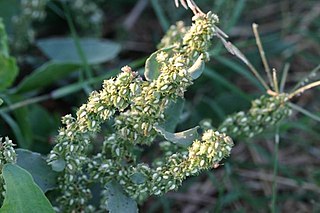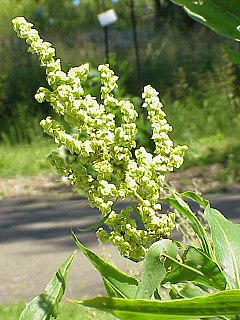
The docks and sorrels, genus Rumex, are a genus of about 200 species of annual, biennial, and perennial herbs in the buckwheat family, Polygonaceae. Members of this genus are very common perennial herbs with a native almost worldwide distribution, and introduced species growing in the few places where the genus is not native.

Rumex crispus, the curly dock, curled dock or yellow dock, is a perennial flowering plant in the family Polygonaceae, native to Europe and Western Asia.

Rumex obtusifolius, commonly known as bitter dock, broad-leaved dock, bluntleaf dock, dock leaf or butter dock, is a perennial plant in the family Polygonaceae. It is native to Europe, but is found on all temperate continents. It is a highly invasive species in some zones, resulting from its abundant seed dispersal, adaptability to reproduce, aggressive roots, ability to tolerate extreme climates, and hardiness.

Rumex longifolius, commonly known as the dooryard dock or northern dock, is a perennial species of plant in the genus Rumex.

Isoetes engelmannii is a species of aquatic plant in the family Isoetaceae. It is referred to by the common names Engelmann's quillwort or Appalachian quillwort, and is the most widely distributed species of its genus in eastern North America. Its range extends from Ontario in the north, south to Florida and west Arkansas and Missouri. It can be found from April to October in temporary pools, bogs, marshes, stream edges, swamps and along wet roadsides.

Tephroseris palustris, also known by its common names swamp ragwort, northern swamp groundsel, marsh fleabane, marsh fleawort, clustered marsh ragwort and mastodon flower, a herbaceous species of the family Asteraceae. It can be seen most easily when its bright yellow umbel flowers appear from May to early July standing 3 to 4 feet along marshes, stream banks and slough areas where it likes to grow.

Rumex hydrolapathum, the great water dock, water dock, or giant water dock, is a species of perennial herbaceous plants in the genus Rumex native to fens and freshwater banks of Europe and Western Asia. It is the tallest species in the genus, with flowering stems attaining a height of up to 2 m. It is one of the small number of decaploid organisms, containing two hundred individual chromosomes.

Rumex stenophyllus is a species of flowering plant in the knotweed family known by the common name narrow-leaf dock. It is native to Eurasia and it can be found in parts of North America as an introduced species and roadside weed. It grows in moist and wet habitat, often in areas with saline soils. It is a perennial herb producing an erect stem from a thick taproot, usually measuring 40 to 80 centimeters tall, but known to well exceed one meter. The leaves are up to 30 centimeters long and are generally lance-shaped with curled edges. The inflorescence is an interrupted series of clusters of flowers with 20 to 25 in each cluster, each flower hanging from a pedicel. The flower has usually six tepals, the inner three of which are largest, triangular and edged with teeth, and bearing tubercles.

Rumex brownii, the hooked dock, Browne's dock or swamp dock, is a leafy perennial herb native to Australia, and is widespread and grows in disturbed sites. It is an introduced weed in the Pacific Islands, England, Japan, and New Zealand.
Rumex kerneri is a species of flowering plant in the knotweed family known by the common name Kerner's dock. It is native to Europe. It has also been observed in California as an introduced species and roadside weed. It is a perennial herb producing a slender, erect stem from a thick taproot, approaching 1.5 meters in maximum height. The lance-shaped leaves can be up to 25 centimeters long and have smooth, wavy, or wrinkly edges. The inflorescence is an interrupted series of clusters of flowers, with 15 or 20 in each cluster, each flower hanging from a pedicel. The flower has usually six tepals, the inner three of which are largest, about 6 millimeters long, edged with tiny teeth and bearing rounded tubercles in the centers.

Rumex pulcher is a species of flowering plant in the knotweed family known by the common name fiddle dock. It is native to Eurasia and North Africa and it can be found elsewhere, including parts of North America, as an introduced species and a roadside weed. Europe. It is quite variable in appearance, and some authorities divide it into several subspecies that are more or less distinguishable. In general, it is a perennial herb producing a slender, erect stem from a thick taproot, approaching 70 centimeters in maximum height. The top of the plant may bend, especially as the fruit develops. The leaves are up to 10 or 15 centimeters long and variable in shape, though often oblong with a narrow middle in the rough shape of a fiddle. The inflorescence is made up of many branches, each an interrupted series of clusters of flowers with up to 20 in each cluster, each flower hanging from a pedicel. The flower has usually six tepals, the inner three of which are edged with teeth and have tubercles at their centers.

Rumex salicifolius is a species of flowering perennial plant in the knotweed family known by the common names willow dock and willow-leaved dock. It is native to much of western North America, and more specifically, in southern and central parts of California, and some parts of Arizona and Nevada. It can also be found in parts of Europe as an introduced species and a roadside weed. It is an extremely variable plant which is generally divided into many varieties, some of which may actually be specimens of other species.

Rumex venosus is a species of flowering plant in the knotweed family known by the common names veiny dock, winged dock, sand dock, and wild-begonia. While not of any particular agricultural use, its cousins rhubarb and buckwheat are. It is native to central and western North America, from southern parts of the Canadian prairies, through to Mexico.

Decodon verticillatus, the sole species in the genus Decodon, is a flowering plant in the family Lythraceae. It is commonly known as waterwillow or swamp loosestrife. It is native to wetlands in the eastern half of the United States and Canada.

Rumex pseudonatronatus, common name field dock or Finnish dock, is a plant species native to northern Europe and northern Asia, known from Asiatic and European Russia, China, Mongolia, Kazakhstan, Kyrgyzstan, Finland, Norway, Sweden, Belgium, Netherlands, Estonia, Latvia, Lithuania, Poland, Belarus, etc. It is naturalized in much of Canada and to the north-central United States. It is known from every Canadian province from Québec to British Columbia, plus Yukon, North Dakota, South Dakota and Minnesota. It grows in wet and/ore disturbed sites along stream banks, lake shores, roadsides, ditches, cultivated fields, meadows, etc.

Rumex britannica is a flowering plant species in the family Polygonaceae.(Buckwheat family) (perennial).

Rumex fueginus, known as American dock, golden dock, and Tierra del Fuego dock, is a flowering plant in the family Polygonaceae. Rumex fueginus was first formally named by Rodolfo Armando Phillipi. Rumex fueginus is native from Canada in northern North America to Tierra del Fuego at the southern tip of South America. It has previously been considered a subspecies or variety of Rumex maritimus, a Eurasian species.

Rumex occidentalis is a flowering plant species belonging to the family Polygonaceae. Commonly known as western dock, Rumex occidentalis can be found in parts of Western North America.
Rumex floridanus is a perennial flowering plant, in the family Polygonaceae. The common name for this species is Florida dock.
Rumex fascicularis is a plant from the family Polygonaceae. This specific plant species experiences perennial growth and is originally found in North Carolina. Rumex fascicularis is from the genus Rumex, which are herbs and it is commonly seen growing near swamps, shores of rivers and lakes.

















